Maximum Residue Limits: Pause
In Spring, 2021 PMRA proposed to increase the levels of Glyphosate in food. Safe Food Matters and other groups started a campaign to enlist public comments, and the response was overwhelmingly against the proposal. As a result, the Government announced a “pause” on the increases, and embarked on a “Transformation Agenda” for PMRA.
See:
- Health Canada Wants to Increase Glyphosate in Food (2021-07-10)
- How to Take Action on Glyphosate (2021-07-17)
- Update: Comment ‘til September 3 on Glyphosate MRL Increases (2021-07-21)
- UPDATE 2: GOVERNMENT PAUSES MRL INCREASES, AND WILL REVIEW PARTS OF THE ACT; BUT MORE IS NEEDED (2021-08-08)
- Pesticide Reform: Letter to Ministers (2021-08-15)
- 2023 01 23 Letter to Minister on MRLs
The confidential test data for the proposal was provided to Safe Food Matters only after the public comment period had closed, and SFM discovered significant shortcomings in the data. SFM provided its comments explaining these concerns to PMRA in April, 2022 (pursuant to an agreed upon extension). See: 2022 04 13 – Comments to PMRA on GLY increases in PMRL 2021-01 PMRA has not yet moved to increase the levels of glyphosate in food.
PMRA must publish its response to the comments if it ever does increase the MRLs under the proposal. See: Glyphosate MRL Proposal Not Based on Sound Science. (And in French: LMR de glyphosate non fondées scientifiquement)
The problems include: overestimation of maximum residue limits (MRLs); different exposure scenarios than in Canada; outdated, irrelevant dietary consumption data; and ignoring data that showed residues increase, instead of decrease (as was assumed), following the spray date.
Transformation Agenda
PMRA launched a Transformation Agenda to address concerns of the public, including increasing MRLs. Safe Food Matters provided comments to the consultation on the “Targeted Review” of the PCPA launched in March, 2022. The comments, and a summary of them, can be found here: Comments on Targeted Review of PCPA. Smaller posts about the three objectives of the review are here:
- Consultation on Targeted Review of Pesticides Act: MRLs and Continuous Oversight
- Consultation on Targeted Review of Pesticides Act: Improved Transparency
- Consultation on Targeted Review of Pesticides Act: Real-World Data and Independence
MRL Pause Lifted and Notice of Intent 2023-01
PMRA’s answer for Transformation was to launch a Notice of Intent to issue new regulations, NOI2023-01. It went ahead with increasing pesticide levels in food -s – the “pause” was lifted on June 20, 2023. The NOI does nothing to reduce pesticides, and do everything to maintain the status quo and continue increasing MRLs. The NOI proposed issuing a notice when an MRL is going to be increased, and also dealt with confidential test data, species at risk and environmental cumulative effects. See:
Update: PMRA Transformation Agenda, Increasing MRLs and Action
Update 2 on Increasing MRLs: Comments due Sept 8 2023 and MRL Issues Summary
Resignation of Co-Chair of Scientific Advisory Committee
Meanwhile, the C0-Chiar of the Scientific Advisory Committee (SAC), resigned. The SAC was one of the creations of the Transformation Agenda, but Dr. Bruce Lanphear provided a scathing indictment of the SAC in his resignation letter. See: Key Scientist Resigns from PMRA’s Scientific Advisory Committee
First MRL Increases Based on Flawed Science
PMRA published PMRL 2023-34 on Fludioxonil (FL) on June 27, 2023, and PMRL 2023-38 on Azoxystrobin (AZ) on July 20, 2023. From the lifting of the pause on June 20, 2023 through September 2023, PMRA has proposed new MRLs for ten pesticides, and they keep on coming.
Syngenta Canada Inc. asked for the increases to FL and AZ, because they are both ingredients in one of their fungicide products. PMRA did not assess the two chemicals together, or the full fungicide products, as it would be used in the “real-world”. It also completely ignored the fact that the OECD Caclulator, which is the calculator used by PMRA to set the proposed new pesticide levels, contained the warning, in red, that there was high uncertainty of the MRL estimate because of a small dataset. There were less than 10 data points in the data set.
See this article and our Hallowe’en post.
Here is our combined submission to PMRA (revised) on PMRL 2023-34 (Fludioxonil) and PMRL 2023-38 (Azooxystrobin): SFM Comments on MRL Increases: FL & AZv2Revs

